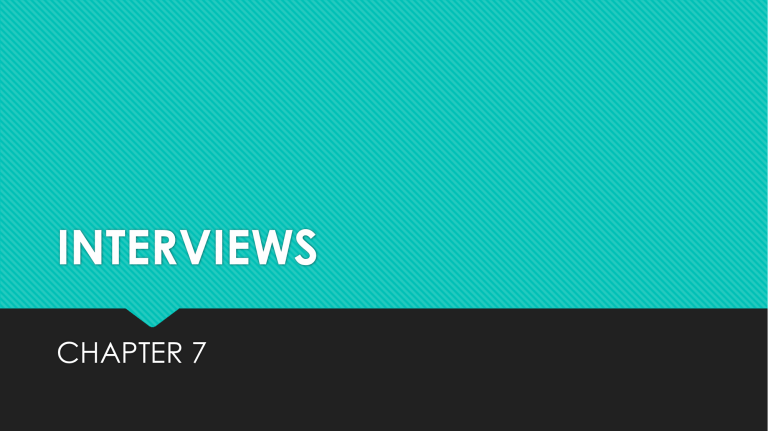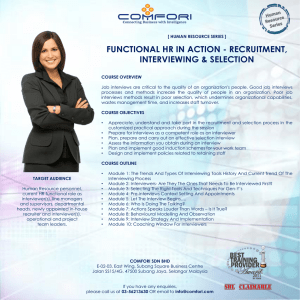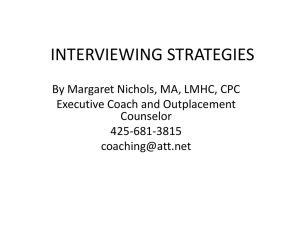INTERVIEWS CHAP 7
advertisement

INTERVIEWS CHAPTER 7 INTRODUCTION Interview is the process of exchange of information between two or more people. They help you explain, better understand, and explore research subjects' opinions, behavior, experiences, phenomenon, etc. What is interview in research method? An interview in qualitative research is a conversation where questions are asked to draw out certain information. Purpose Purpose of interview is to help us explain, better understand, and explore research subjects' opinions, behavior, experiences, phenomenon, etc. Collect data for research purposes. PRIMARY DATA COLLECTION METHODS Some primary data collection methods are interviews, field observation, experiments and questionnaires. Type of method to use depends upon objectives, research questions, strategies, accuracy, span of study, stc. UNOBTRUSIVE METHODS: Unobtrusive methods do not require the researcher to interact with the people he or she is studying. Unobtrusive methods are sometimes used by researchers who seek to understand what people actually do ,instead of what they say they do. e.g. hidden microphones or cameras observing behaviour and doing garbage audits to determine consumption INTERVIEWS ‘’An interview is a guided, purposeful conversation between two or more people’’ An interview is a qualitative research. The interviewer is usually a professional, paid researcher or sometimes trained. They can be contrasted with focus group but structured and unstructured are discussed first. Structured: The use of a set of pre-determined questions. Highly standardized techniques of recordings. The use of fixed, alternative questions. The use of close ended questions. Mostly used in quantitative research. Un structured: Non-standardize interviewing. Do not follow a list of pre-determined question. It is very complex process. Use open ended question. It is only used in qualitative research Training Interviewers Interviewers must be fully briefed on the research and trained on how to conduct an interview. Personal interviews generate a lot of information. Personal interviews are expensive in terms of time, training costs, and use of resources. Some tips to follow when interviewing The information obtained during the interviews should be as free as possible. The interviewer could bias the data if proper trust and rapport are not established with the interviewee. Interviewees can bias the data when they do not come out with their true opinions but provide information that they think is what the interviewer expects. There should no unfairness during the interview. Some interviewees may be turned off because of personal likes and dislikes. Continued Biases could be situational as well, in terms of: 1- nonparticipants, 2- trust levels and rapport, 3- the physical setting of the interview. The actual setting in which the interview is conducted might sometimes introduce bias. The interviewer can also reduce bias by being consistent with the questioning mode as each person is interviewed. Strategies to minimize Bias Establishing credibility and rapport, and motivating individuals to respond: The projection of professionalism and confidence is more important for the interviewer. The researcher should be able to make the respondent sufficiently to give answer. This should encourage the respondents to feel secure about responding. Researchers can motivate respondents to offer honest and truthful answers The questioning technique Funneling: It is advisable to ask open‐ended questions to get a broad idea. Unbiased questions: It is important to ask unbiased questions to ensure that you minimize bias in the responses. Clarifying issues: To make sure that the researcher understands issues. The questioning technique Helping the respondent to think through issues: If the respondent is not able to verbalize her perceptions then the researcher should ask the question in a simpler way. Taking notes: It is Important that the researcher makes written notes, should not rely on memory. The interviews can be recorded on tape if the respondent has no objection. Sources of bias in interview data • When the interviewee is not in good humor • Personality of interviewer • Introductory sentence • Inflection of voice • People with unlisted numbers Computer assisted interviewing CATI(Computer - assisted telephone interviewing) CAPI(Computer – assisted personal interviewing) CATI Cati is basically use to conduct surveys It is conducted through software in systems and respondent answers the questions Computerized voice activated interviews are also possible for short survays CAPI CAPI is self administered program One respondent got software automatically enters their response VCS allow computer to capture respondent answers in digital mode and stored in data file Advantages of CAI Time saving Automate results Low cost Quick Accurate Faster and easier analysis of data Software packages Field notes taken by interviewers and hand coded data which is tedious and time consuming Now, days software are available which can ease the job of interviewers FACE TO FACE AND TELEPHONIC INTERVIEWS Mode of conduction of interviews can depend on factors such as • Geographical factors • Duration of Interviews • Convenience of both parties Interviews can either be: • Face to Face • Telephonic ADVANTAGES AND DISADVANTAGES Advantages: Questions can be adapted according to the conditions Researcher/Interviewer can pick nonverbal cues from the respondent Respondent’s weaknesses can easily be detected by his/her facial expressions Disadvantages: Geographical limitations High costs of training interviewers/researchers reduce interviewer bias Low comfort level of respondents Example: Job Interview TELEPHONIC INTERVIEWS Advantages: Easy to reach maximum people in minimum time High comfort level of Respondents Disadvantages: Unilateral termination of interview by respondent without informing Respondent’s strengths and weaknesses cannot be detected due to no nonverbal communications Solutions: Advisable to call the respondent before time to request participation Inform him/her about the length of the interview Avoid unnecessary prolonging of interview Example: Survey ADDITIONAL SOURCES OF BIAS IN INTERVIEW DATA Bias data is obtained when respondents are busy or when they are not in good humor. Discussion about certain issues such as strikes, layoffs could also add bias. Interviewer’s personality, introductory sentence, inflection voice Sampling biases like inability to contact people with changed phone numbers Uncontacted people with unlisted numbers Solutions Awareness of different biases Introduction of Caller ID Group Interview Several candidates are interviewed simultaneously for similar positions. Efficient and time saving. There are two types of group interviews 1. Group interviews ( single interviewer interviewing multiple candidates at the same time). 2. Panel interviews ( panel of multiple members of a hiring team interviewing a single job candidate). FOCUS GROUPS Consists of eight to ten members with a moderator leading a discussion on a specified topic. For example developing new product, discussing concept Inexpensive and provide relevant data in short time frame Expert Panel Used when specialized input and opinion is required for an evaluation Advantages and disadvantages of interview Advantages Disadvantages Ability to find the right candidate Highly time consuming Enables detailed assessment Risk oof personal bias Great source of information Quick to judge Increases knowledge Can easily form stereotypes Understanding stakeholders better Hard to verify the truth Extracting additional information Unpredictable outcome



